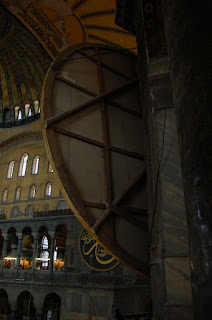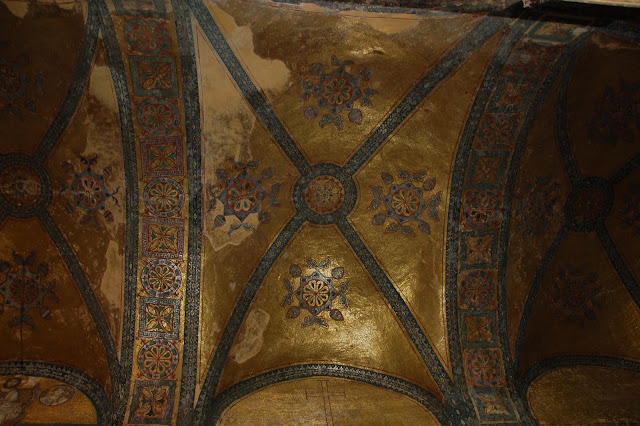Thursday morning I was unencumbered by appointments, fellow travelers
or anything, but I did get a later start than I wanted to because I got to be
so late the night before (see part 1 of this blog post). I got out the door shortly after 10 and got
on a scarcely populated bus. Turks seems
to stay at home during the mornings and come out en masse in the midafternoons. This suits me just fine, now that I have
figured it out, since I would rather be out in the morning while it is
cooler. Even the shore road was
relatively empty and I got to Kabitas in no time, transferred to the tram
(which was more crowded as I approached tourist land) and out at
Sultanamet.
I had not made up my mind if I was going in to the Blue
Mosque or not. I was wearing calf
length pants, but I had no scarf for my head, so I walked around it in search
of the serpent tower first. Ann and I
just finished a book called “The Serpent Stone,” a mystery which takes place in
Istanbul in the early 1800s. I have found it very useful for making place names
familiar and giving me a few details about the city. The serpent tower is missing its heads which
is what gives the book its title. There was also an Egyptian obelisk there and it seemed to get more interest from the other tourists. This whole area is known as the hippodrome, where horse races used to amuse the locals back in the day. I saw where they were taking down the ramazan bazaar shops and it looked like they were getting ready to re-sod some grass that had been worn out by the extra traffic of ramazan.
A ‘helpful’ person told me that the mosque would only be
open for another hour before prayer time and that galvanized me into
action. After a miss-start, I went around
to the side where visitors can enter.
There was quite a crowd (little did I know) and everyone was vieing for
position on these stairs that lead up to the entrance. I would guess that most of the people there
could have passed as Turkish, so I wasn’t sure why they all were going in the
visitors entrance (Turkey is 99% Muslim to some degree). Another reason I thought they could be
Turkish was their queing skills. They
are very good at filling any gap and getting just that much farther ahead. This skill is especially useful when trying
to get on a bus early enough to get a seat or even to get on at all.
I eventually made it up to the shoes off station. We were handed plastic bags to put our shoes in so we could carry them through the mosque. I cant imagine the hassle of making sure that everyone got their own shoes back when they exit with this number of visitors. There was also someone passing out cloths, and I expected to need one to cover my head, but when I asked he said ‘no need,’ they were just for the shoulders of people wearing tank tops, or the knees of people wearing shorts.
Inside it was beautiful.
The mosque gets its name from the blue tiles used to adorn the
inside. It was all patterns and more
patterns. The ceilings were very tall
and all covered in tiles. In order to
make it light at human level, there was a network of hanging lights. Unfortunately they were all on wires which obstructed
the view of the beautiful ceilings. I’ll
let the pictures speak for themselves, knowing that they are a poor
representation of what it really looked like.I eventually made it up to the shoes off station. We were handed plastic bags to put our shoes in so we could carry them through the mosque. I cant imagine the hassle of making sure that everyone got their own shoes back when they exit with this number of visitors. There was also someone passing out cloths, and I expected to need one to cover my head, but when I asked he said ‘no need,’ they were just for the shoulders of people wearing tank tops, or the knees of people wearing shorts.
Once out, I headed to Hagia Sophia, or Holy Wisdom. This building looks largely similar to the
Blue Mosque from the outside (all architects and locals are probably cringing),
but really they both have domes and minarets and are grey and dull from the
outside.
The first church built on this spot was built by Constantine in 360AD, but it was burned down. Then Theodosios II built another one in 415, but it was burnt and then demolished, again by a public rebellion. Emperor Justinian vowed to build a church that could not be burned down, so he built the current incarnation out of stone in 537. It functioned as a basilica in the Eastern Orthodox church until Sultan Mehmed II conquered Istanbul in 1453 (see the post about the Rumeli Fortress). He turned it into a mosque. As I said before, Muslims don’t allow any icons or faces in their mosques, so the faces of the angels in the ceiling were blocked and the mosaics of Christ, Mary and the usual gang were plastered over.
It is a good thing too, since they probably wouldn’t have survived to be rediscovered if they had been out in the open.
The minarets were added as was the Mihrab (or alcove) that faces mecca. (You can see that the mihrab is not quite centered in the front of the church. Christians built the building to face Jerusalem, but the Muslim renovators revere Mecca, which is in a slightly different direction.)
The giant golden medallions contain beautiful calligraphy of the 7? names of God as well as other important Muslims.
I was particularly interested in the marble carvings on the wall below waist height. They all had the same idea, but they each had something different in the center.
Someone saw me taking pictures of them and he pointed to one that had been scratched out and said, ‘cross.’ I have no way of confirming this, but it makes sense that the panels with crosses in them would have been defaced, either by the Muslims when they moved in or even before when the crusaders were through. (I don’t know enough about the crusades, but I don’t understand why they would plunder a church, but from what I have read, that is what they did. They were the ones that took all the valuables from Hagia Sophia, hundreds of years before the Ottomans got there and brought Islam with them to Istanbul.) The building has been a museum since 1934 when Ataturk said so.
One interesting story our guide told us was the ramp to the
second level. Apparently women were only
allowed to worship on the second floor, but they were too snooty to walk, so
they were carried in their sedan chairs.
Stairs are bumpy, so they made a ramp up and a ramp down. The building was beautiful. The first church built on this spot was built by Constantine in 360AD, but it was burned down. Then Theodosios II built another one in 415, but it was burnt and then demolished, again by a public rebellion. Emperor Justinian vowed to build a church that could not be burned down, so he built the current incarnation out of stone in 537. It functioned as a basilica in the Eastern Orthodox church until Sultan Mehmed II conquered Istanbul in 1453 (see the post about the Rumeli Fortress). He turned it into a mosque. As I said before, Muslims don’t allow any icons or faces in their mosques, so the faces of the angels in the ceiling were blocked and the mosaics of Christ, Mary and the usual gang were plastered over.
It is a good thing too, since they probably wouldn’t have survived to be rediscovered if they had been out in the open.
The minarets were added as was the Mihrab (or alcove) that faces mecca. (You can see that the mihrab is not quite centered in the front of the church. Christians built the building to face Jerusalem, but the Muslim renovators revere Mecca, which is in a slightly different direction.)
The giant golden medallions contain beautiful calligraphy of the 7? names of God as well as other important Muslims.
I was particularly interested in the marble carvings on the wall below waist height. They all had the same idea, but they each had something different in the center.
Someone saw me taking pictures of them and he pointed to one that had been scratched out and said, ‘cross.’ I have no way of confirming this, but it makes sense that the panels with crosses in them would have been defaced, either by the Muslims when they moved in or even before when the crusaders were through. (I don’t know enough about the crusades, but I don’t understand why they would plunder a church, but from what I have read, that is what they did. They were the ones that took all the valuables from Hagia Sophia, hundreds of years before the Ottomans got there and brought Islam with them to Istanbul.) The building has been a museum since 1934 when Ataturk said so.
I liked all the marble and the domes and columns and things. I can appreciate the amount of work it would take to make the mosaics, but gold saints and emperors really aren’t my thing. I’ll let you decide based on these pictures.





















































No comments:
Post a Comment